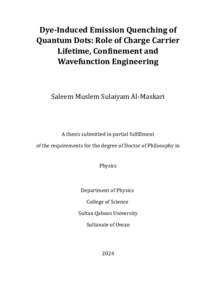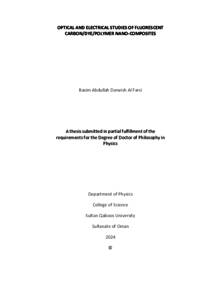Document
Dye-induced emission quenching of quantum dots : role of charge carrier lifetime, confinement and wavefunction engineering.
Source
Doctoral dissertation
Other titles
تبريد انبعاث الكوانتم دوت الناجم عن الصبغة : دور عمر حاملات الشحنة والحبس والهندسة الموجية
Country
Oman
City
Muscat
Publisher
Sultan Qaboos University
Gregorian
2024
Language
English
Thesis Type
Doctoral dissertation
English abstract
Optical excitation of semiconductor quantum dots (QDs) generates electron-hole
pairs, and their radiative recombination yields intrinsic photoluminescence (PL).
However, this absorption-emission cycle is often interrupted due to the trapping
of photoexcited charge carriers into localized electronic states, commonly known
as traps. Generally, the trapping of charge carriers quenches the QD emission,
hence lowering the PL quantum yield. This thesis work investigates the role of the
excited state lifetime, charge carrier’s confinement, and wavefunction
engineering of core/shell and core/shell/shell cadmium-free QDs in charge
trapping due to the attachment of dye molecules on the QD surface.
In the first part, PL quenching of nanoassemblies of CuInS2/ZnS (CIS) QDs and
rhodamine 560 molecules (Rh560) is spectroscopically investigated by steadystate and femtosecond-to-nanosecond time-resolved techniques. Transient
absorption measurements of the CIS-Rh560 assemblies resolved the fast
component of electron trapping that occurs in tens to hundreds of picoseconds,
while PL lifetime measurements resolved the slow components of trapping that
occur in hundreds of nanoseconds. Unlike traditional CdSe/ZnS QDs, the PL
lifetime of CIS QDs approaches the typical time scale of fluorescence
intermittency. As a result, the excited state of CIS QDs is vulnerable to the blinking
process and the weight of dynamic quenching increases, which leads to an
upward curvature in the Stern-Volmer plot.
In the second part, PL quenching of nanoassemblies of CIS and InP/ZnS (InP) QDs
with Rh560 and rhodamine 575 (Rh575) dye molecules of different ionic
characters (Rh560; cationic and Rh575; zwitterionic) is investigated. These QDs
show different excited state lifetimes and electron confinement energies. CIS
exhibits a lifetime ca. 290 ns and weak confinement energy of 664 meV whereas
InP has a lifetime ca. 37 ns and strong confinement energy of 1194 meV, SternVolmer analysis shows that (i) dynamic quenching is dominating in all QD-dye
assemblies with only a minor contribution from static quenching and (ii)
quenching is generally more pronounced in CIS-dye assemblies as compared to
InP-dye assemblies. These results are explained on the basis of differences in
electron trapping rates in QD-dye assemblies due to the charge carriers'
wavefunction extension onto the QDs' shell surface. In addition, Rh560 dye
exhibits a stronger interaction in comparison to Rh575 dye. This is attributed to
the variation in electrostatic interaction between the dyes and the partial negative
charges of the QD shell surface.
Finally, PL quenching of InP/ZnS core/shell (InP CS) and InP/ZnSe/ZnS
core/shell/shell (InP CSS) QDs in the assembly with Rh560 and Rh575 dye
molecules is investigated. The major observation is that the steady-state and
bimolecular quenching rate constants of CSS QDs are 7.5 to 21.7 times larger than
that of CS QDs. Interestingly, the direct excitation of dye molecules in the QD-dye
assembly leads to the efficient excitation energy transfer from dye to the CS QDs,
which yields QD’s PL recovery. Energy transfer is less efficient in CSS QDs and
exhibits a net QD PL quenching. Moreover, in CSS QD-dye assemblies, the PL
quenching rate is 6.1 to 39.5 times higher than the energy transfer rate.
Arabic abstract
تعتمد معظم تطبيقات حصاد الضوء الاصطناعي على امتصاص الضوء الفعال والطاقة المستحثة ضوئياً أو على عمليات نقل الشحنة بين الأجزاء المانحة والمستقبلة في التجمعات النانوية العضوية وغير العضوية. لقيت أشباه الموصلات الكوانتم دوت اهتماما كبيرمواد غير عضوية متعددة الاستخدامات بسبب خصائصها الضوئية والإلكترونية المتعددة على الحجم وسميتها الأقل وكذلك توافقها الحيوي.
Category
Theses and Dissertations


